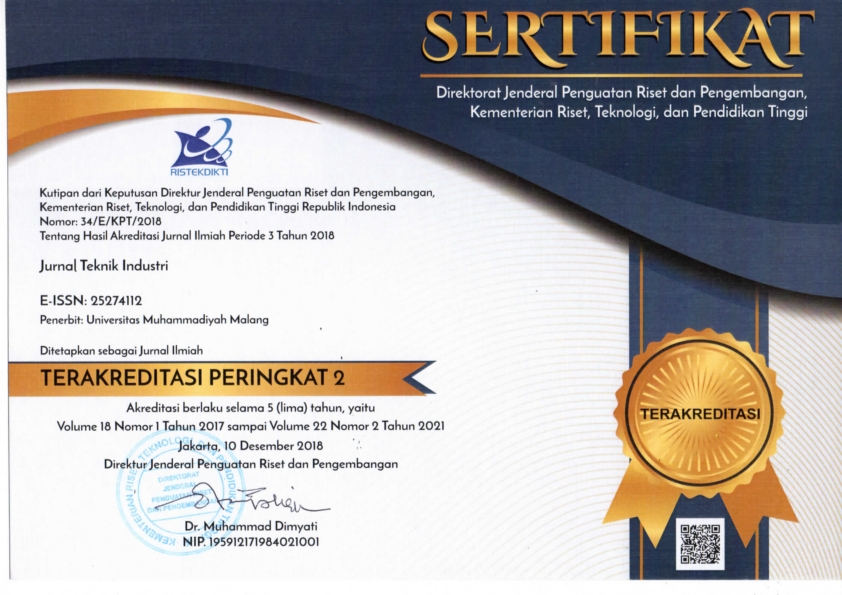Purchasing Inventory Models for Deteriorating Items with Quadratic Demand
DOI:
https://doi.org/10.22219/JTIUMM.Vol20.No2.204-217Keywords:
Inventory, Deteriorating, Quadratic Demand, Lot size.Abstract
This paper deals with purchasing inventory replenishment policy for deteriorating items, considering the time-dependent quadratic demand and time-dependent backlogging. Two models were formulated and solved. First, it is for deteriorating items with quadratically time-dependent demand for deteriorating items. Second, quadratically time-dependent demand for deteriorating items and shortages. A mathematical model is developed to the fourth-order equation for each model. The optimal production lot size, which minimizes the total cost, is derived. Sensitivity analysis is carried out to demonstrate the effects of changing parameter values on the optimal solution of the system. Numerical examples are taken to illustrate the procedure of finding the optimal inventory cost, cycle time, and optimal lot size. The numerical experiment in this model was coded in Microsoft Visual Basic 6.0.
Downloads
References
[1] F. W. Harris, "How many parts to make at once," Operation Research, vol. 38, pp. 947-950, 1990. https://doi.org/10.1287/opre.38.6.947.
[2] U. Dave and L. Patel, "(T, S i) policy inventory model for deteriorating items with time proportional demand," Journal of the Operational Research Society, vol. 32, pp. 137-142, 1981. https://doi.org/10.1057/jors.1981.27.
[3] S. Bose, A. Goswami, and K. Chaudhuri, "An EOQ model for deteriorating items with linear time-dependent demand rate and shortages under inflation and time discounting," Journal of the Operational Research Society, vol. 46, pp. 771-782, 1995. https://doi.org/10.1057/jors.1995.107.
[4] K. Skouri and S. Papachristos, "A continuous review inventory model, with deteriorating items, time-varying demand, linear replenishment cost, partially time-varying backlogging," Applied Mathematical Modelling, vol. 26, pp. 603-617, 2002. https://doi.org/10.1016/S0307-904X(01)00071-3.
[5] S. Ghosh, K. Chaudhuri, and Optimization, "An order-level inventory model for a deteriorating item with Weibull distribution deterioration, time-quadratic demand and shortages," Advanced Modeling, vol. 6, pp. 21-35, 2004. https://camo.ici.ro/journal/vol6/v6a2.pdf.
[6] S. Ghosh and K. Chaudhuri, "An EOQ model with a quadratic demand, time-proportional deterioration and shortages in all cycles," International Journal of Systems Science, vol. 37, pp. 663-672, 2006. https://doi.org/10.1080/00207720600568145.
[7] A. Roy, "An inventory model for deteriorating items with price dependent demand and time varying holding cost," Advanced modeling optimization, vol. 10, pp. 25-37, 2008. https://camo.ici.ro/journal/vol10/v10a2.pdf.
[8] M. Cheng and G. Wang, "A note on the inventory model for deteriorating items with trapezoidal type demand rate," Computers Industrial Engineering, vol. 56, pp. 1296-1300, 2009. https://doi.org/10.1016/j.cie.2008.07.020.
[9] C. K. Jaggi and P. Verma, "Two-warehouse inventory model for deteriorating items with linear trend in demand and shortages under inflationary conditions," International Journal of Procurement Management, vol. 3, p. 54, 2010. https://doi.org/10.1504/IJPM.2010.029775.
[10] B. Mandal, "An EOQ inventory model for Weibull distributed deteriorating items under ramp type demand and shortages," Opsearch, vol. 47, pp. 158-165, 2010. https://doi.org/10.1007/s12597-010-0018-x.
[11] T. Roy and K. Chaudhuri, "A finite time horizon EOQ model with ramp-type demand rate under inflation and time-discounting," International Journal of Operational Research, vol. 11, pp. 100-118, 2011. https://doi.org/10.1504/IJOR.2011.04033.
[12] M. Cheng, B. Zhang, and G. Wang, "Optimal policy for deteriorating items with trapezoidal type demand and partial backlogging," Applied Mathematical Modelling, vol. 35, pp. 3552-3560, 2011. https://doi.org/10.1016/j.apm.2011.01.001.
[13] N. Kumar, S. R. Singh, and R. Kumari, "An inventory model with time-dependent demand and limited storage facility under inflation," Advances in Operations Research, vol. 2012, 2012. http://dx.doi.org/10.1155/2012/321471.
[14] T. Sarkar, S. Ghosh, and K. Chaudhuri, "An optimal inventory replenishment policy for a deteriorating item with time-quadratic demand and time-dependent partial backlogging with shortages in all cycles," Applied MathematicsComputation, vol. 218, pp. 9147-9155, 2012. https://doi.org/10.1016/j.amc.2012.02.072.
[15] V. K. Mishra, L. S. Singh, and R. Kumar, "An inventory model for deteriorating items with time-dependent demand and time-varying holding cost under partial backlogging," Journal of Industrial Engineering International, vol. 9, p. 4, 2013. https://doi.org/10.1186/2251-712X-9-4.
[16] S. K. De and S. S. Sana, "An EOQ model with backlogging," International Journal of Management Science Engineering Management, vol. 11, pp. 143-154, 2016. https://doi.org/10.1080/17509653.2014.995736.
[17] P. Manna, S. K. Manna, and B. C. Giri, "Economic Order Quantity Model with Ramp Type Demand Rate, Constant Deterioration Rate and Unit Production Cost," Yugoslav Journal of Operations Research, vol. 26, 2016. http://www.yujor.fon.bg.ac.rs/index.php/yujor/article/view/8.
[18] M. E. Islam, S. I. Ukil, and M. S. Uddin, "A time dependent inventory model for exponential demand rate with constant production where shelf-life of the product is finite," Open Journal of Applied Sciences, vol. 6, p. 38, 2016. https://doi.org//10.4236/ojapps.2016.61005.
[19] N. K. Kaliraman, R. Ritu, S. Chandra, and H. Chaudhary, "Two warehouse inventory model for deteriorating item with exponential demand rate and permissible delay in payment," Yugoslav Journal of Operations Research, vol. 27, pp. 109-124, 2016. http://yujor.fon.bg.ac.rs/index.php/yujor/article/view/22/16.
[20] R. Tripathi, S. Pareek, and M. Kaur, "Inventory model with exponential time-dependent demand rate, variable deterioration, shortages and production cost," International Journal of Applied Computational Mathematics, vol. 3, pp. 1407-1419, 2017. https://doi.org/10.1007/s40819-016-0185-4.
[21] S. Singh, S. Singh, and S. Sharma, "A partially backlogged EPQ model with demand dependent production and non-instantaneous deterioration," International Journal of Mathematics in Operational Research, vol. 10, pp. 211-228, 2017. https://doi.org/10.1504/IJMOR.2017.081926.

Downloads
Published
How to Cite
Issue
Section
License
Copyright (c) 2019 C. K. Sivashankari

This work is licensed under a Creative Commons Attribution-ShareAlike 4.0 International License.
















